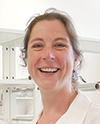Newly appointed tenure-track assistant professor in the department of Organic Chemistry (UNIGE) and the NCCR Chemical Biology, Sascha Hoogendoorn represents the perfect example of the next generation of researchers: she combines organic chemistry training with cell biology and CRISPR/Cas-9 gene editing, to develop molecules that enable further dissection and manipulation of ciliary signaling. Portrait of an unconventional scientist at the onset of her academic career.
Why are you active in the field of chemical biology?
For me chemistry and biology have always been very complementary and I already had a hard time deciding what I wanted to focus on at the bachelor level. But then I thought: why choose? Biology offers fascinating problems waiting to be solved and chemistry provides the means to create useful molecules whose properties you can tune to help answer the questions. So I trained myself in both areas and consequently my research program is very interdisciplinary, ranging from organic synthesis to biochemistry and genetics. I think it is very valuable and satisfactory to not only make tools to probe and understand biology, but to also use them and show their value. And I hope to train the new generation of chemical biologists with this interdisciplinary mindset as well.
Describe the most intense moment of your career.
I’d say right now, starting up my lab is intense – and also very exciting.
Which is the best idea you ever had?
To follow the science and broaden my horizon. I had never imagined at the start of my postdoc that I would transition from organic chemistry-based chemical biology to a genome-wide CRISPR screen. Yet this allowed me to learn a tremendous amount and made me a much better biologist. I strongly believe that it is important for chemical biologists to know the biology of their system. This allows you to understand the questions, come up with the necessary chemical tools, and also properly evaluate and use these tools.
Do you have a role-model or a driving force?
I have been lucky to work with great scientists that all contributed to my development as a chemical biologist. I try to learn something from everyone I work with, and use it to shape myself as a scientist, a mentor, and hopefully, a role-model.
The philosophy along which lines you lead your lab?
Have clear goals in mind but don’t hesitate to go off the beaten track to reach them. And I am very much in favor of collaborations, within and outside the lab, to foster interdisciplinarity and teamwork.
Pick a paper you praise for the elegance of its demonstration.
Rohatgi, R., Milenkovic, L., Scott, M.P., “Patched1 regulates Hedgehog Signaling at the Primary Cilium“, Science, 2007, 372-376.
Can you shed light on the relevance of interdisciplinarity for scientific breakthroughs?
Interdisciplinary science breaks boundaries, leading to creative and unconventional approaches that you wouldn’t think of when staying in the monodisciplinary ‘boxes’. But it requires scientists that are willing to train themselves in multiple areas to form a bridge between the disciplines, capable of communicating with and reaching out to experts in other fields. The resulting synergy will lead to scientific breakthroughs.
Define research with just three words.
Explore the unknown.
How do you match the words beauty and science?
When after hard work and frustration the pieces of a puzzle come together and you have a scientific breakthrough, be it a molecule that does what it was designed to do, or a piece of biological knowledge gained – I think there’s beauty in that.
A piece of advice you’d like to give to the young generation of researchers?
Follow your passion and keep learning, it is never too late to dive into a new area of research if you surround yourself with the right people. Be resilient, the process can be tough, but it is worth it in the end.
A book, song, poem, music or painting that you spot out and get inspiration from?
“The immortal life of Henrietta Lacks” by Rebecca Skloot. Not necessarily for inspiration, but it is good to sometimes stop and think about the history and the ethics of what we are using and developing in the lab.
 Sascha Hoogendoorn is a newly appointed tenure-track assistant professor in the department of Organic Chemistry and the NCCR Chemical Biology at the University of Geneva. She received her PhD in Organic Chemistry from the group of professor Herman Overkleeft at the University of Leiden, the Netherlands in 2013. In her PhD work, she used synthetic chemistry to develop receptor-targeting small molecules to accomplish selective cellular entry. Sascha Hoogendoorn then moved to Stanford University where she worked in the group of Professor James Chen as a postdoctoral scholar, and developed a novel CRISPR/Cas9-based screening methodology to study ciliary Hedgehog signalling.
Sascha Hoogendoorn is a newly appointed tenure-track assistant professor in the department of Organic Chemistry and the NCCR Chemical Biology at the University of Geneva. She received her PhD in Organic Chemistry from the group of professor Herman Overkleeft at the University of Leiden, the Netherlands in 2013. In her PhD work, she used synthetic chemistry to develop receptor-targeting small molecules to accomplish selective cellular entry. Sascha Hoogendoorn then moved to Stanford University where she worked in the group of Professor James Chen as a postdoctoral scholar, and developed a novel CRISPR/Cas9-based screening methodology to study ciliary Hedgehog signalling.

Leave a comment
The editors reserve the right not to publish comments or to abridge them.